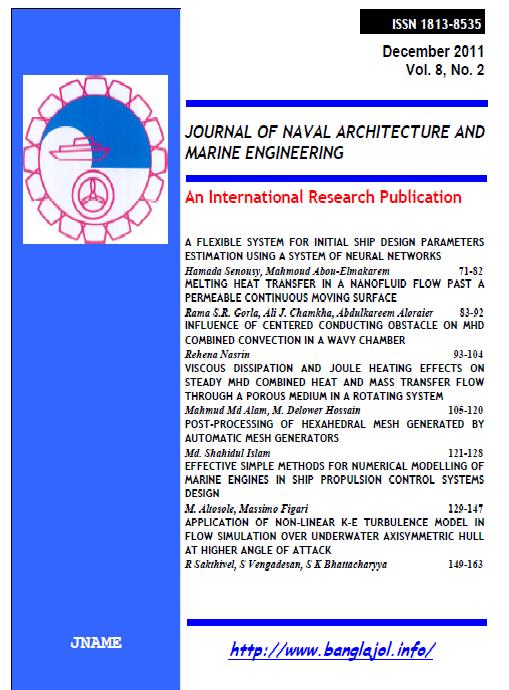Application of non-linear k-e turbulence model in flow simulation over underwater axisymmetric hull at higher angle of attack
DOI:
https://doi.org/10.3329/jname.v8i2.6984Keywords:
Computational Fluid Dynamics (CFD), Autonomous Underwater Vehicle (AUV), Reynolds averaged Navier-Stokes Equation (RANS), non-linear k-? turbulence modelAbstract
This paper addresses the Computational Fluid Dynamics Approach (CFD) to simulate the flow over underwater axisymmetric bodies at higher angle of attacks. Three Dimensional (3D) flow simulation is carried out over MAYA Autonomous Underwater Vehicle (AUV) at a Reynolds number (Re) of 2.09×106. These 3D flows are complex due to cross flow interaction with hull which produces nonlinearity in the flow. Cross flow interaction between pressure side and suction side is studied in the presence of angle of attack. For the present study standard k-ε model, non-linear k-ε model models of turbulence are used for solving the Reynolds Averaged Navier-Stokes Equation (RANS). The non-linear k-ε turbulence model is validated against DARPA Suboff axisymmetric hull and its applicability for flow simulation over underwater axisymmetric hull is examined. The non-linear k-ε model performs well in 3D complex turbulent flows with flow separation and flow reattachment. The effect of angle of attack over flow structure, force coefficients and wall related flow variables are discussed in detail.
Keywords: Computational Fluid Dynamics (CFD); Autonomous Underwater Vehicle (AUV); Reynolds averaged Navier-Stokes Equation (RANS); non-linear k-ε turbulence model
doi: http://dx.doi.org/10.3329/jname.v8i2.6984
Journal of Naval Architecture and Marine Engineering 8(2011) 149-163
Downloads
References
Alin, N., Bensow, R.E., Fureby, C., Huuva, T. and Svennberg U. (2010) : Current capabilities of DES and LES for submarines at straight course, Journal of Ship Research, vol.54, No. 3, pp. 184-196.
Constantinescu , G.S., Pasinato , H., Wang, Q.Y., Forsythe, J.R. and Squires , K.D (2002) : Numerical Investigation of Flow past a Prolate Spheroid, Journal of Fluid Engineering, Vol.124, pp.904-910.
De Barros, E. A., Pascoal, A. and E de Sa. (2008) : Investigation of a method for predicting AUV derivatives, Ocean Engineering, Vol.35, pp.16271636.
De Barros, E. A., Dantas, L. D., Pascoal, A. M. and E de Sa. (2008) : Investigation of normal force and moment coefficients for an AUV at nonlinear angle of attack and sideslip range, Journal of Oceanic Engineering, Vol. 33, no. 4, pp. 583-579.
Hoerner, S.F. (1965) : Fluid dynamics drag, Hoerner Fluid Dynamics, Brick Town.
Huang, T.T., Liu, H.L., Groves. N.C., Forlini, T.J., Blanton, J. and Gowing, S. (1992) : Measurements of flows over an axisymmetric body with various appendages (DARPA SUBOFF Experiments), Proceedings 19th symposium on Naval Hydrodynamics, Seoul, Korea.
ITTC quality manual (1999): Uncertainty analysis in CFD and guidelines for RANS codes, Interim Recommended Procedure Prepared by Resistance Committee of 22nd ITTC.
Liu, H. and Huang, T. (1998) : Summary of DARPA SUBOFF experimental program, Naval surface warfare center carderock division technical report, CRDKNSWC/HD- 1298-11.
Jagadeesh, P., Murali, K. and Idichandy V. G. (2009) : Experimental investigation of hydrodynamic force coefficients over AUV hull form, Ocean Engineering, Vol. 36, pp. 113118.
Jagadeesh, P. and Murali, K. (2005) : Application of low-Re turbulence models for flow simulations past underwater vehicle hull forms, Journal of Naval Architecture and Marine Engineering, Vol.1, 41-54.
Kimura, I. and Hosoda, T. (2003) : A nonlinear k- model with realizability for prediction of flows around bluff bodies, International Journal of Numerical Methods in Fluids, Vol. 42, pp. 817-837.
Myring, D.F. (1976) : A theoretical study of body drag in subcritical axisymmetric
Flow, Aeronautical Quarterly, vol. 27, no. 3, pp. 186194.
Pantelatos, D.K. and Mathioulakis, D.S. (2004) : Experimental flow study over a blunt-nosed axisymmetric body at incidence, Journal of Fluids and Structures, Vol.19, pp. 1103-1115.
Phillips, A., Furlong, M. and Turnock S. R. (2007) : The use of computational fluid dynamics to determine the dynamic stability of an autonomous underwater vehicle, in Proceedings of 10th Numerical Towing Tank Symposium, Hamburg, Germany.
Sarkar, T., Sayer, P.G. and Fraser S.M. (1997) : A study of autonomous underwater hull forms using computational fluid dynamics, International Journal of Numerical Methods in Fluids, Vol.25, pp. 1301-1313.
Sarkar, T., Sayer, P.G. and Fraser S.M. (1997) : Flow simulation past axisymmetric bodies using four different turbulence models, Applied Mathematical Modelling, Vol.21, pp.783-792.
Triantafyllou, S.M. (2004) : Maneuvering control of surface and underwater vehicles, Lecture Notes for MIT Ocean Engineering Course, pp.25-26. http://ocw.mit.edu/courses/mechanical-engineering/2-154-maneuvering-and-control-of-surface-and-underwater-vehicles-13-49-fall-2004/lecture-notes/
Tyagi, A. and Sen D. (2006) : Calculation of transverse hydrodynamic coefficients using computational fluid dynamic approach, Ocean Engineering, Vol.33, pp.798-809.
Virag, M., Vengadesan, S. and Bhattacharyya, S.K. (2011) : Translational Added Mass of Axisymmetric Underwater Vehicles with Forward Speed using Computational Fluid Dynamics, Journal of Ship Research (accepted for publication).
Wetzel, T.G., Simpson, R.L. and Chesnakas, C.J. (1998) : Measurement of Three-Dimensional cross flow separation, American Institute of Aeronautics and Astronautics, Vol. 36, No. 4, pp. 557-564.
Downloads
Additional Files
Published
How to Cite
Issue
Section
License
Please download the Copyright Transfer Agreement and send it after duly filled in.
Link to FaceBook


